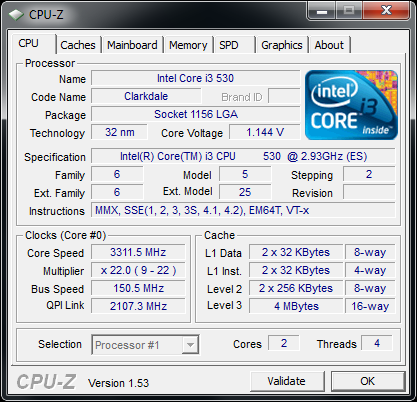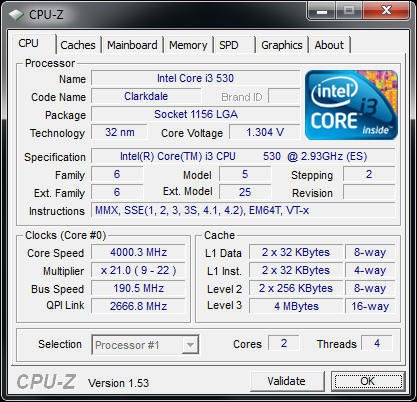The Intel Core i3 530 Review - Great for Overclockers & Gamers
by Anand Lal Shimpi on January 22, 2010 12:00 AM EST- Posted in
- CPUs
Overclocking the i3 - 4GHz with the Stock Cooler
I’ve become a fan of stock voltage overclocking over the past few years. As power consumption and efficiency has become more important, and manufacturing processes improved, how far you can push a CPU without increasing its core voltage appears to be the most efficient way to overclock. You minimize any increases in power consumption while maximizing performance. You really find out whether or not you’ve been sold a chip that’s artificially binned lower than it could have.
With Bloomfield, Intel hit a new peak for how far you can expect to push a CPU without increasing voltage. AMD followed with the Phenom II, but Lynnfield took a step back. Thanks to its on-die PCIe controller, Lynnfield needed some amount of additional voltage to overclock well. Clarkdale is somewhere in between. It lacks the crippling on-die PCIe controller, but it’s also a much higher volume part which by definition shouldn’t be as overclockable.
The Core i3 530 runs at 2.93GHz by default, with no available turbo boost. Without swapping coolers or feeding the chip any additional voltage, the most I got out of it was 3.3GHz (150MHz BCLK x 22). Hardly impressive.

I added another 0.16V to the CPU’s core voltage. That’s just under 14%. And here’s what I was able to do:

That’s 4GHz, stable using the stock heatsink/fan. Part of the trick to overclocking this thing was lowering the clock multiplier. Despite always keeping the QPI and memory frequencies in spec, lowering the clock multiplier on the chip improved stability significantly and allowed me to reach much higher frequencies.
I could push beyond 4GHz but that requires more voltage and potentially better cooling. With a stable 4GHz overclock, I was happy.
If you’ll remember from my review of the processor, my Phenom II X2 550 BE managed 3.7GHz using the stock cooler and a pound of voltage. Unfortunately it’s not enough to challenge the overclocked 530.
| CPU | x264 HD 3.03 - 2nd pass | 7-zip KB/s | Batman: AA | Dawn of War II | Dragon Age Origins | World of Warcraft |
| Intel Core i3 530 @ 4GHz | 18.4 fps | 2822 | 192 fps | 62.7 fps | 115 fps | 92 fps |
| AMD Phenom II X2 550 @ 3.7GHz | 10.4 fps | 2681 | 170 fps | 50.9 fps | 63 fps | 60.8 fps |
| AMD Phenom II X4 965 (3.4GHz) | 22.2 fps | 3143 | 196 fps | 54.3 fps | 109 fps | 74.1 fps |
Even an overclocked Athlon II X4 630 isn’t going to dramatically change things. It’ll still be faster in multithreaded applications, and still the overall slower gaming CPU.
If the Core i3 530 is right for you, overclocking is just going to make it more right.










107 Comments
View All Comments
MadMan007 - Friday, January 22, 2010 - link
The Clarkdale CPUs are that much less efficient, likely because of the off-die but on-package memory controller not to mention only 2 'real' cores. It's more like having a fast-connected Northbridge in a traditional FSB arrangement than the on-die memory controller of Lynnfield. ardocp did their Clarkdale review with set speeds and no Turboboost and Clarkdale needed a lot more clockspeed to equal Lynnfield. That's why the i5-600 CPUs make little sense unless you desparately want the combination of certain features and integrated graphics, they are too close in price to the i5-750.StormyParis - Friday, January 22, 2010 - link
95 euros for Gigabyte 13566 UD2H, vs 80 for their 785G. That's 20-25 US dollars. At least, both have DVI and HDMI, contrary to Intel Atom 510 board (what were they thinking ?)Calin - Friday, January 22, 2010 - link
I would still prefer integrated graphics from AMD/ATI - but did you saw (or felt) any graphical issues with the integrated graphic from Intel?I'm waiting for the next IGP from AMD/ATI, based on what the current competition is, it should be much better than what Intel has now.
Egowhip69 - Thursday, January 28, 2010 - link
Picked up one of these things... along with a gigabyte ga-h55m-ud2h board.Having AWFUL issues with random reboots. Changed the Memory, PSU, HDD, you name it... then I uninstalled the intel graphics and changed the chip to an i5... no problems.
Just to check, I threw the i3 back in... but no intel drivers... no reboots on a 3 day burn in... added the drivers back... reboot within 45 min.
Both on Win7 pro 64bit, and Xp pro 32bit.
Intel's drivers are VERY immature at the moment...
bupkus - Friday, January 22, 2010 - link
Anand, does the table showing the results of the 4GHz i3 530 overclock include a graphics overclock as well?Calin - Friday, January 22, 2010 - link
The game results with the 4GHz overclock are obtained with a heavy-duty video card, there's no way the integrated graphics would get such results.What I'd like to know is - was the integrated graphic chip active during that 4GHz overclock? And how much could one push the i3 with active (eventually downclocked) internal graphic?
Anand Lal Shimpi - Friday, January 22, 2010 - link
Correct. The IGP wasn't running, only the Radeon HD 5870. I haven't tried to figure out the max overclock while pushing both the CPU and the GPU, I'd guess it'd be relatively similar though. The two chips are physically separate, so as long as you can adequately remove the heat of the GPU you should be fine.Take care,
Anand
notty22 - Friday, January 22, 2010 - link
Your going to catch some flak for deeming this a overall better gaming cpu , in a chart comparing it to a amd 965.nerdtalker - Friday, January 22, 2010 - link
The i3 is creeping surprisingly close to the i7 920, too close for my comfort, in fact./goes and overclocks i7 920 even more
kwrzesien - Friday, January 22, 2010 - link
/goes and turns down the thermostat